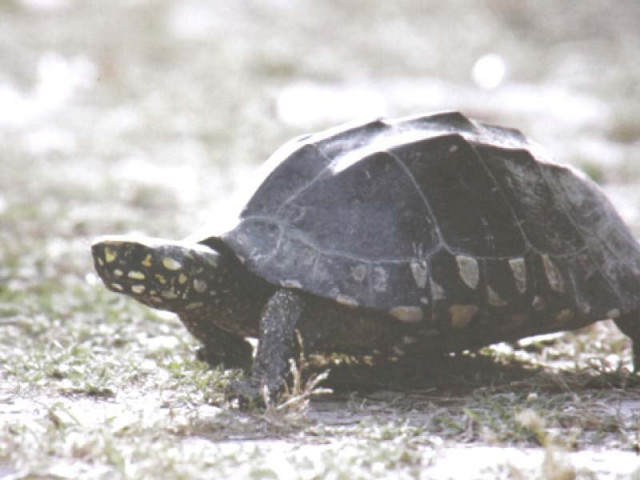Turtles of Karachi are protected, but what of their habitat?
New research provides invaluable data about the nesting habits and preferences of the endangered species.

Virtually all marine turtles’ nesting sites in Sindh are on the Hawksbay and Sandspit beaches, concentrated along one five-kilometre stretch, but extending in some degree along the entire beach strip. These two beaches constitute as one of the most important green turtle nesting sites in the world.
Sea turtles enjoy a protected status in Pakistan. However, an issue of major concern is that even though the turtles are protected, their nesting habitats, including the Karachi beaches, are not.
Due to various human activities, the habitat is severely threatened and turtle nesting is on the decline. Beach front developments in the form of huts often violate land use and a number of huts exceed the limits of legally allowed land usage. Consequently, space for turtle nesting is severely restricted. The beaches often contain large amounts of litter, consumption of which may interfere in the turtles’ metabolism. The garbage also attracts predators that pose an immediate threat to the turtle eggs and hatchlings. Construction debris on the beaches can alter the characteristics of the sand and hence deter nesting attempts and interfere with incubation of eggs and the emergence of hatchlings.

Use of lighting in huts during the night discourages female turtles from nesting and causes hatchlings to become disoriented as they are instinctively attracted towards the light, which should be guiding them towards the moonlit ocean but in this case takes them away from it. They therefore wander inland, where they either die of dehydration or become easy prey for predators.
New information, renewed hope
While organisations like the Sindh Wildlife Department and the World Wide Fund for Nature have been doing commendable work in protecting turtle hatchlings in hatcheries and documenting nesting counts, not much focus was directed towards studying the species-habitat interaction and how it was affecting the nesting patterns.
However, a not-for-profit organisation, Shehri-Citizens for a Better Environment, recently conducted a project called the ‘GIS [Geographic Information Systems] Mapping of Karachi coast and GIS based analysis of marine turtle habitat: Sandspit/Hawksbay Eco-system’ that was funded under the Indus for All Programme’s Partnership Fund by WWF-Pakistan.
The project used the GIS planning tool to gain an understanding of the nesting patterns and processes with a focus on analysing critical interactions between turtle nesting and the physical and environmental attributes of the beach.
Successful and unsuccessful nesting sites were marked and related with data on mean sand depth, beach access based on obstructions to nesting access such as huts and potential predators. This helped in analysing and identifying causes and locations of hindrances to turtle nesting.

Source: Farhan Anwar
The nesting grounds were divided into three separate categories; low, medium and high level. In doing so, an interesting observation was made. It was found that while the entire stretch of the beach had an area of 13,120 square metres, 52% of all documented nests along the 9km beach strip were located on a 0.78 km sand bar; an elevated platform of the beach delineated through satellite imagery and field data generation.
A direct relationship was established between the elevation of the sand bar and the increasing numbers of successful turtle nests. The turtles were found to nest mostly in the elevated sandbar area as it was easier for them to safely dig nests to the desired depths. In addition, some key characteristics such as soil composition, ground water level, slope and gradient and high water mark were studied and linkages established with turtle nesting.
The survival of the species is linked to the protection and sustainable development of its habitat. The GIS map serves as useful information documentation, analytical and planning tool for policy and decision makers; planners and conservationists alike. The product has established a scientific basis for properly describing nesting habitats, monitoring changes over time, their impact on the nesting habitats and modelling geographic processes inferred from predicted changes. Now it is up to the relevant government agencies, non-governmental organisations and research bodies to make viable use of this work to ensure long term nesting sustainability of this critical ecosystem.
Published in The Express Tribune, July 21st, 2014.



















COMMENTS
Comments are moderated and generally will be posted if they are on-topic and not abusive.
For more information, please see our Comments FAQ